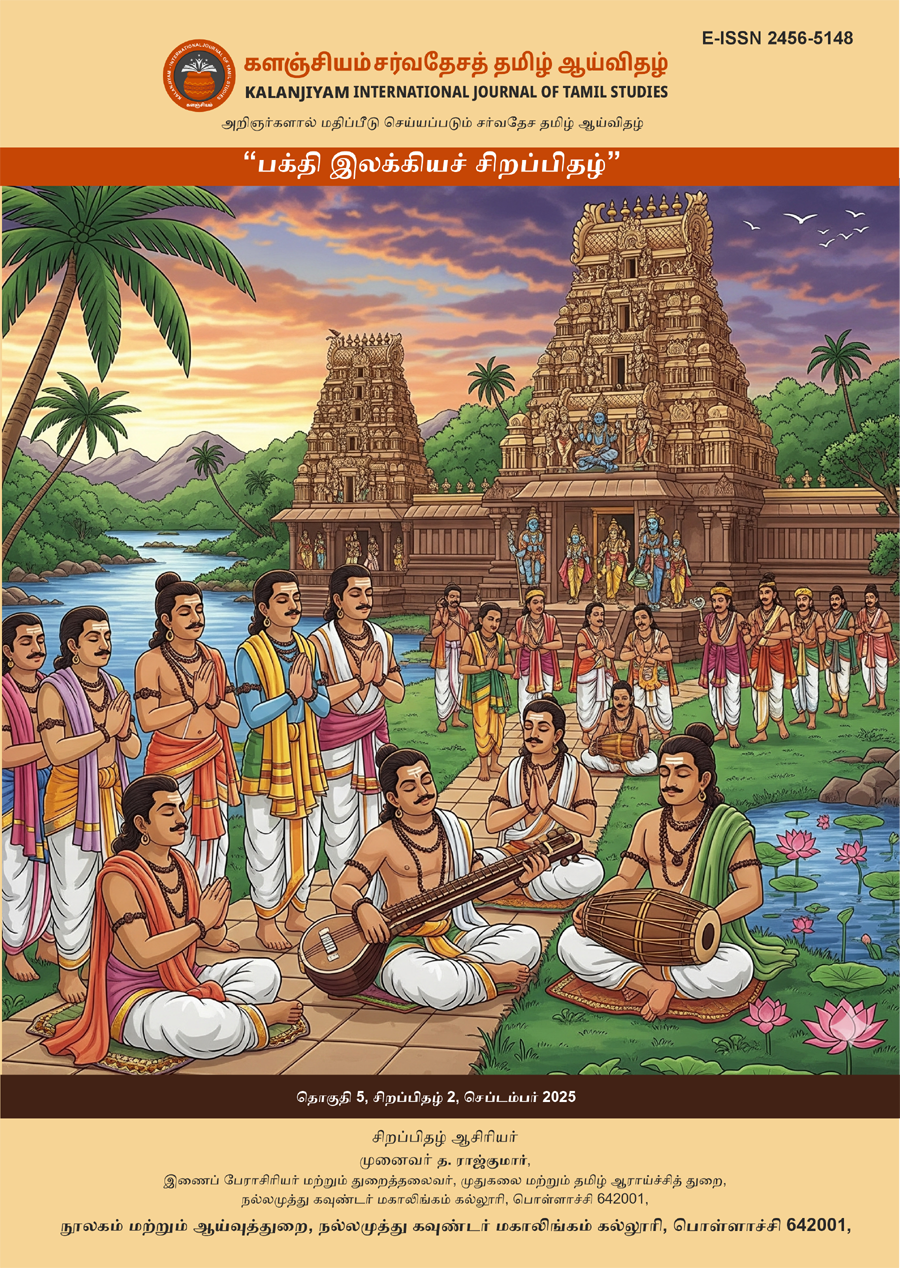ஆழ்வார்களின் பக்தி நெறி
THE DEVOTIONAL PRACTICE OF THE ALWARS
Keywords:
Bakthi Ilakkiyam, Azhwars, Karma Yoga, Jnana Yoga, Bhakti YogaAbstract
Bhakti is the great love for God. The Azhwars, who were well aware of the Karma Yoga, Jnana Yoga and Bhakti Yoga shown to attain God, chose the path of devotion from it. In that path of devotion, they especially adopted the path of surrender called Prabhakti and gave it to everyone. Although the Azhwars lived in different periods from the 5th to the 9th century AD, the consensus among them is clearly visible when you read their collection of works, Nalayira Divya Prabandham. The reason for that is that God himself expressed himself through their words, as they say. This world is God's farmland. God is the tiller. He sows the seed of devotion. God himself descends from his Paramapada and takes incarnations and comes to this world. Vaishnavites believe that God takes many incarnations to protect righteousness, destroy unrighteousness, and protect those who surrender to Him. The Puranas and Ithikas were revealed by sages and sages to tell the news and stories about those incarnations. The Azhwars largely use the ideas of these books in their songs. Every living being born in this world should live a life connected with the Supreme Lord; the Azhwars believed that the only goal of their life should be to please Him. Therefore, they showed a simple path of devotion to receive the grace of God, to obtain the joy of God, and to enjoy the life of the world in this world itself.
ஆய்வுச் சுருக்கம்:
இறைவன் மீது கொள்ளும் பேரன்பே பக்தியாகும். இறைவனை அடைவதற்காகக் காட்டப்பட்ட கர்மயோகம், ஞான யோகம், பக்தியோகம் இவைகளைப் பற்றி நன்கு அறிந்திருந்த ஆழ்வார்கள் அதில் பக்திநெறியைப் தேர்ந்து எடுத்தனர். அந்த பக்தி நெறியிலும், பிரபக்தி என்று கூறப்படும் சரணாகதி நெறியினைச் சிறப்பாகக் கொண்டு அனைவருக்கும் அதனை அளித்தனர். ஆழ்வார்கள் கி.பி.5 முதல் கி.பி. 9 ஆம் நூற்றாண்டு வரை வெவ்வேறு காலகட்டங்களில் வாழ்ந்தாலும் அவர்களது படைப்புத் தொகுப்பான நாலாயிர திவ்ய பிரபந்தத்தைப் படிக்கும்போது அவர்களுக்கிடையில் உள்ள கருத்தொற்றுமை நன்கு புலப்படும். அதற்குக் காரணம் இறைவனே விரும்பி அவர்கள் வாக்கின் வழித் தன்னை வெளிப்படுத்திக் கொண்டான் என்பர். இவ்வுலகம் இறைவனது விளைநிலம். இறைவன்தான் உழவன். பக்தி என்னும் விதையை அவன் விதைக்கிறான். இறைவனே தன் பரமபதத்திலிருந்து இறங்கி அவதாரங்கள் எடுத்து இவ்வுலகிற்கு வருகிறான். தர்மத்தைக் காக்கவும் அதர்மத்தை அழிக்கவும் தன்னைச் சரண் அடைந்தாரைக் காக்கவும் இறைவன் தானே விரும்பி பற்பல அவதாரங்கள் எடுக்கிறான் என்பது வைணவர் நம்பிக்கை. அந்த அவதாரங்கள் பற்றிய செய்திகளையும் கதைகiளையும் கூற புராணங்கள், இதிகாசங்கள் ஆகிய நூல்கள் ஞானிகளாலும், முனிவர்களாலும் அருளப்பட்டன. ஆழ்வார்கள் பெரிதும் இந்த நூல்களின் கருத்துக்களையே தம் பாடல்களில் கையாளுகின்றனர். இவ்வுலகில் பிறந்த ஒவ்வொரு ஜீவனும் பரமாத்வாகிய இறைவனுடன் தொடர்பு கொண்ட வாழ்வினைத்தான் வாழ வேண்டும். அவனது முகமலர்ச்சி ஒன்றே தம் வாழ்வின் குறிக்கோளாக இருக்க வேண்டும் என்று ஆழ்வார்கள் கருதினர். எனவே இறை அருள் பெறவும், இறையின்பம் பெற்று மேலுலக வாழ்வினை இந்த பூவுலகிலேயே அனுபவித்து பேரின்பம் பெற்றிடவும் எளிய பக்தி வழியினைக் காட்டினர்.
பிரதான சொற்பதங்கள்: பக்தி இலக்கியம், ஆழ்வார்கள், கர்ம யோகம், ஞான யோகம், பக்தி யோகம்
Downloads
References
1.கலைக்களஞ்சியம் 4ஆம் தொகுதி –பக்451,452
2. கலைக்களஞ்சியம் 4ஆம் தொகுதி –பக்456,
3. இந்துமத இணைப்பு விளக்கம் -பக்-65
1. Encyclopedia of Arts Volume 4 – Page 451,452
2. Encyclopedia of Arts Volume 4 – Page 456,
3. Hinduism Connection Explanation – Page-65
Downloads
Published
Issue
Section
License
Copyright (c) 2025 Dr. A. Devatha (Author)

This work is licensed under a Creative Commons Attribution 4.0 International License.
Our journal adopts CC BY License Creative Commons Attribution 4.0 International License http://Creativecommons.org//license/by/4.0/ . It allows using, reusing, distributing and reproducing of the original work with proper citation.


